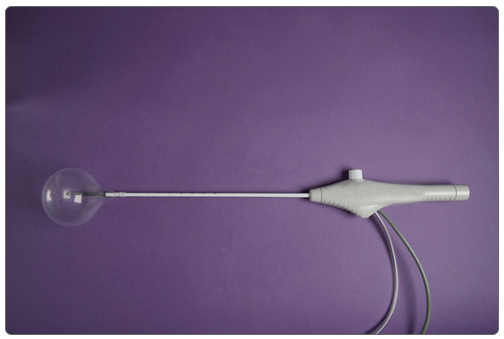Breast surgery
Adnexa surgery
Uterine surgery
Cervical surgery
Vulvar surgery
Other
Endometrial thermal ablation
Indications and surgical procedure
A few years before the menopause, the menstrual cycle can fluctuate and bring to excessive or abnormal vaginal bleeding. Further to a discussion between the doctor and his patient and a complete clinical exam, various benign pathologies will possibly be diagnosed (polyps, fibromas, endometriosis) and relevant treatment may then be recommended.
According to the national recommendations in France, “in the event of failure of the medical care, a preserving surgical procedure will have to be suggested; choice of procedure must be driven by the endometrium destruction techniques of 2nd generation (“thermal small balloon”)” (cf national recommendations of the French obstetric and gynecologic college).
The thermal-ablation by balloon is a procedure that destroys the uterus lining, also called endometrium. This specific operation lasts 15 minutes, and does not require any incision. It is performed using either a general anesthesia or epidural or spinal block. The uterus is preserved.
After having visualized the uterus using the hysteroscope (light viewing instrument) and having carried out a systematic biopsy, a flexible balloon attached to a small catheter (tube) is transvaginally inserted, through the cervix and then placed into the uterine cavity. The balloon is made of silicone – cutting of the latex allergy threats. The balloon is filled in with a saline solution, in order to fit the sharps of the uterus. The fluid inside the balloon is heated to the point that the endometrial tissues are eroded away. When the treatment is finished, the liquid of the balloon is withdrawn and the medical device is removed. The endometrium will heal by scaring, all treated tissues will flow down like menses.
Riks & Complications
Even if surgery procedures and technics are meticulous, it is not possible to guarantee neither therapeutic success nor a complete absence of intraoperative complications.
During the operation
- Accidental puncture (perforation) of the uterine wall: it can prevent the realization of the act which was initially envisaged. Usually, a simple antibiotherapy is required, associated with a 24 hours monitoring at the hospital. The intervention will have to be postponed to the next month.
- Significant blood loss: may rarely lead to a blood transfusion.
- Exceptional risk of burn (thermal injury) due to the perforation of the balloon and the release of the liquid heated in the uterus, in the vagina, on the vulva. Burn tissues will then require specific treatment for burns.
Post-operation
A urinary or uterine infection (endometritis) and/or of the Fallopian tubes (salpingitis) can occur and require an antibiotic treatment.
Last update: 10/2/2013

